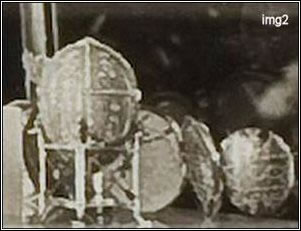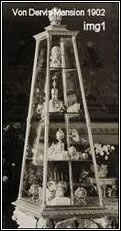The Fabergé Imperial Easter Eggs: New Discoveries Revise Timeline by Annemiek Wintraecken
(First published in the Fabergé Research Newsletter, November 2008)
The Question:
The Blue Serpent Clock Egg is currently on view in an American museum for the first time ever. Ulla Tillander-Godenhielm, Christel Ludewig McCanless and I discussed it on email, and Dr. Tillander-Godenhielm asked for my thoughts on the Egg and its place in the chronology published in Fabergé Imperial Easter Eggs (1997) by Tatiana Fabergé, Lynette G. Proler and Valentin V. Skurlov.
We both agreed that the Blue Serpent Clock Egg perhaps was dated a little too early in the egg timeline, since the Fabergé workshops probably were not ready in 1887 for such a sophisticated egg. We discussed the 1902 von Dervis exhibition (img1) in which the Egg was clearly visible in the centre of the showcase. Dr. Tillander-Godenhielm asked if I could find another plausible place in the timeline and she sent me some high resolution images of the showcases with Fabergé items belonging to the Empresses Maria and Alexandra Feodorovna.
|
Von Dervis Exhibition
Case |
These images at first did not reveal any secrets and I searched my books about the Eggs. Slowly a pattern became visible and the von Dervis photographs helped me to get the pieces of my puzzle in the right spots.
The Answer:
There are four parts to my hypothesis:
- The Blue Serpent Clock Egg is the egg belonging to the Fabergé invoice of the year 1895.
- The 1895 Twelve Monogram Egg is the same egg as the missing 1896 Alexander III Portraits Egg.
- For the year 1887, a new (now missing) Imperial Easter Egg has emerged. (Ed. Note: Discovered in 2011, Parke-Bernet, New York, March 6-7, 1964, auction catalog.)
- Bonus Discovery.*
1. The Blue Serpent Clock Egg is the 1895 Egg
Searching for another place in the Fabergé Egg timeline for the 1887 Blue Serpent Clock Egg, I discovered the invoice of the 1895 Twelve Monogram Egg also fits the Blue Serpent Clock Egg. The invoice of the 1895 Egg reads:
"Blue enamel egg, Louis XVI style, 4500 rubles" [1]
I wondered whether the 1895 Twelve Monogram Egg really was a Louis XVI style egg, and I asked Dr. Tillander-Godenhielm, if both eggs belonged to the Louis XVI style. She responded the Blue Serpent Clock Egg is in the Louis XVI style and, although the Twelve Monogram Egg has elements of that style, the egg is not. The first piece of the puzzle was in place. Other pieces are:
Marina Lopato in a 1993 essay, "A Few Remarks Regarding Imperial Easter Eggs", states "Neither the indicated price ... nor the style corresponds to such an early date (i.e., 1887)" [2], and "The gold markings of the latter (Blue Serpent Clock Egg) limit its production to no later than 1895/1896". [3]
I began thinking about the amount of time Fabergé had to make this egg, in view of the death of Tsar Alexander III on November 1, 1894, and I concluded the Fabergé workshop probably started right after Easter in April 1894 on Maria Feodorovna's egg. Franz Birbaum, Fabergé's head workmaster, states in his memoirs:
"The process of making these eggs usually took about one year. Work started soon after Easter, and they were only just ready for Holy Week of the following year". [4]
So, if one of the two 1895 eggs was to be a relatively simple one, it could not have been the Dowager Empress' egg; it was the egg for Tsarina Alexandra for which there was barely half a year to make it. Based on the above, I concluded the Fabergé invoice of the 1895 could be the invoice of the Blue Serpent Clock Egg.
2. The Twelve Monogram Egg is the missing 1896 Alexander III Portraits Egg
Since the Blue Serpent Clock Egg could be the 1895 egg, I had to find another place for the egg now in that position, for there could not be two 1895 eggs for the Dowager Empress. After reading all the invoices again, I found the invoice of the 1896 (missing Alexander III Portraits) Egg also fits the Twelve Monogram Egg:
"Blue enamel egg, 6 portraits of H.I.M. Emperor Alexander III, with 10 sapphires, rose-cut diamonds and mounting, 3575 rubles"[5]
The Twelve Monogram Egg is visible in Tsarina Maria Feodorovna's case, third shelf from the top, possibly with miniatures (img2).
 Twelve Monogram Egg
Twelve Monogram Egg
The Twelve Monogram Egg has six panels, divided into twelve half panels. The upper six panels are decorated with 'AIII', the monogram of Alexander III. The lower six display the monogram of the Empress, 'AF'. The couple married in 1866 and had Alexander III lived, they would have celebrated their 30th wedding anniversary in 1896.
There simply seems to be no other explanation then that the Twelve Monogram Egg and the missing Alexander III Portraits Egg are one and the same egg, namely the 1896 Egg. Consequently, the place in the timeline for the 1895 Egg is available for the Blue Serpent Clock Egg.
So far I found the answer to the question Dr. Tillander-Godenhielm had asked. As so often happens when questions are answered, new questions arise, and my research was no exception.
3. For the year 1887, a new (now missing) Imperial Easter Egg has emerged
The Blue Serpent Clock Egg now being the 1895 egg, there is a vacancy for an egg belonging to the year 1887. What egg could that be and what do we know about it? What happened to it? Does it still exist? Can it be found?
Since the showcase of the Dowager Empress is only partly visible, I can only speculate about the objects that are seen. Possibly eggs are hidden from view behind bigger objects on the lower three shelves.
There is, however, an object that could be an egg on the left of the second shelf from the top. Could this "round object" be the new unknown and missing Fabergé Easter Egg (img3)?

1887 Third Imperial Easter Egg |
Some of the descriptions for the 1887 Egg in Fabergé/Proler/Skurlov fit this unknown object, and so do some of the descriptions in the account books of N. Petrov, Assistant Manager to the Cabinet and the List of Confiscated Treasures:
"Easter egg with clock, decorated with diamonds, sapphires and rose-cut diamonds - 2160 r" [6]
"Gold egg with clock with diamond pushpiece on gold pedestal with 3 sapphires and rose-cut diamond roses" [7]
"Gold egg with clock on diamond stand (?) on gold pedestal with 3 sapphires and rose-cut diamonds" [8]
This "object" is discussed below (November 2007) by Anna and Vincent Palmade as possibly being the missing Nécessaire Egg. Soon after this was published, Kieran McCarthy of Messrs. Wartski shared an archival photograph (see below April 2008 Anniversary Edition) of the Nécessaire Egg contradicting this finding.
A Bonus Discovery*
The "Twelve Monogram Egg/missing Alexander III Portraits Egg" is seen in the von Dervis exhibition in a stand now associated with the Pelican Egg. Speculating on this find, I made a computer composition of modern photographs of the "Twelve Monogram Egg/missing Alexander III Portraits Egg" and the Pelican Egg stand.
Shown below is the first egg in the second egg's stand, and then compared to the original detail on the 1902 von Dervis photograph (img4). I was sure that it was the same stand. Whether the stand was made for the Egg it is seen in, I cannot tell. The invoices in Fabergé/Proler/Skurlov (1997) give no information on a stand, nor for the "Twelve Monogram Egg/missing Alexander III Portraits Egg", or for the 1898 Pelican Egg. [9]

Twelve Monogram Egg in 1902 in the Von Dervis Case
The same stand is seen again in an archival Gokhran (the Soviet Precious Metals and Gemstones Repository) photograph dated 1923 together with the Pelican Egg (img5). Is it possible that during or after the confiscation of the Imperial treasures, the stand of the "Twelve Monogram Egg/missing Alexander III Portraits Egg" and the Pelican Egg were mixed up, and have ever since then been attributed as belonging together?
|
|
Confiscated Treasures with an Enlargement of the Pelican Egg with Stand |
|
Acknowledgements
My thanks to Fabergé author and scholar Ulla Tillander-Godenhielm for asking this challenging question and clarifying the different Louis styles, to my Fabergé friend and art historian Timothy Adams for helping me identify the stand, and to Christel Ludewig McCanless for being my friend and never tiring "Fabergé tutor".
References
[1] Fabergé, Tatiana, Proler, Lynette G. and Valentin V. Skurlov. The Fabergé Imperial Easter Eggs, 1997, 240. (invoice 1094, March 31 purchase).
[2] von Habsburg, Géza, and Marina Lopato, Fabergé Imperial Jeweler, 1993, 73.
[3] Lowes and McCanless, Fabergé Eggs: A Retrospective Encyclopedia, 2001, 23 (Background Notes).
[4] von Habsburg, Géza, and Marina Lopato. Fabergé: Imperial Jeweler, 1993, 453.
[5] Fabergé/Proler/Skurlov, 123, 241.
[6] Ibid., 94, 236.
[7] Ibid., 98.
[8] Ibid., 256 (item 682/1548).
[9] Ibid., 135, 242 (item 5240/1845).
Image Credits
img1, img2, img3 - Archival Photographs, Archives Tatiana Fabergé (Courtesy Dr. Tillander-Godenhielm)
img4 - Composition of images available on the Internet (image editing by the author)
img5 - Archival Photograph available on the Internet
Updates:
* 2013 - No bonus discovery. After seeing for the first time a picture of the side of the 1898 Pelican Egg, I am now convinced that the Egg and stand belong together. (AW)
March 2014 - Discovery and first color pictures of the Third Imperial Egg. See Egg for more.
Page updated or corrected:
February 12, 2019
|







